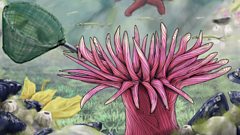Anemone
Brett Westwood explores the role sea anemones have played in culture. They seem to occupy two realms, the seashore and underwater, and were viewed as flowers of the sea. From 2015.
Sea anemones are also known as the flowers of the sea. They inspire whimsy and fancy, poetry and art. The Victorian craze for aquariums which Philip Henry Gosse encouraged with his 1860 book "A History Of The British Sea-anemones and Corals" was intense, though short lived, and had an ecological effect in nature.
Today the collection of anemones for aquariums is devastating places like the Philippines, especially since the Hollywood blockbuster Finding Nemo was released. Bizarrely the complexity of anemone nerves means they are more closely related to humans than to flies and worms. Some species are as close to immortal as you can get. Cut them in half and you get two, cut off the mouth and it will grow a new one. They seem to go on and on, leading some scientists to use them in the search for eternal youth. The Natural History Museum in London owns delicate, anatomically accurate and beautifully crafted glass models of anemones are so realistic they look like the real thing crystallised from the sea. They were made by father and son glass blowers called Blaschka in the 19th century. These models allowed ordinary people to see the wonders beneath the sea.
Original Producer : Andrew Dawes
Archive Producer : Andrew Dawes for �鶹�� Audio
Revised Repeat : First Broadcast �鶹�� Radio 4; 6th October 2015
Last on
![]()
How to dodge creatures and difficult questions when armed with a bucket and net.
![]()
How to pronounce 'anemone' (do doo be-do-do)
Learn how to say 'anemone' with this simple Muppets-inspired guide.
![]()
The World According to Anemone
Natural Histories Comedy - Not every sea anemone wants to live forever.
![]()
Producer Mary Colwell considers whether sea anemones could hold the key to immortality.
Clips
-
![]()
The Victorian ‘craze’ for home marine aquaria
Duration: 01:55
-
![]()
Sea anemones ‘can live forever’
Duration: 01:12
-
![]()
The World According to Anemone
Duration: 01:40
-
![]()
How to pronounce 'anemone' (do doo be-do-do)
Duration: 00:35
Miranda Lowe

She is involved in many public events at the Museum that promote the Museum’s science and collections to wider audiences, including Nature Live sessions, Members tours and VIP tours. She is also a spokesperson at Science Ambassador Days in Schools.
Dr Keith Hiscock

He became interested in sea anemones after reading books by Philip Henry Gosse while at school and visiting the shores he described to find those same species of anemones. He started diving in 1969 and that year was the first person to discover the spectacularly colourful sunset cup coral in Britain at Lundy.
He is the author of and now chairs the .
Picture: Neil Hope
Professor Ralph Pite
He is currently writing a book about the poets, Robert Frost and Edward Thomas. They were close friends in the three years before Thomas’s death in 1917, at the Battle of Arras. Both men shared a love of nature and an interest in ‘the simple life’ – in ways of living, which we would call sustainable.
Dr Andrew Rhyne

He is developing methods for breeding and rearing popular species in aquaria and his body of work illuminates life histories, husbandry and larval rearing requirements of many wild ornamental fish and invertebrate larvae.
He is an Associate Professor at Roger Williams University in Bristol, Rhode Island, and is a Research Scientist at the in Boston,��Massachusetts.
Professor Dan Rokhsar

He and his team conducted the , which revealed it to be nearly as complex as the human genome. It offered major insights into the common ancestor of not only humans and sea anemones, but of nearly all multi-celled animals.
Professor Rebecca Stott

The book is called Theatres of Glass: The Woman who Brought the Sea to the City.
Broadcasts
- Tue 6 Oct 2015 11:00�鶹�� Radio 4
- Mon 12 Oct 2015 21:00�鶹�� Radio 4
- Sun 30 May 2021 06:35�鶹�� Radio 4










